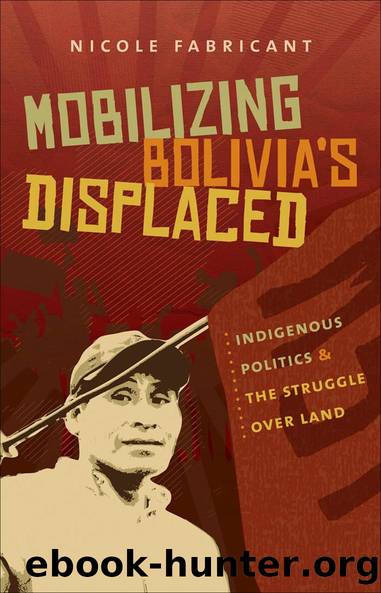Mobilizing Bolivia's Displaced by Nicole Fabricant

Author:Nicole Fabricant [Fabricant, Nicole]
Language: eng
Format: epub
Tags: History, Latin America, South America, Social Science, Anthropology, Cultural & Social, Ethnic Studies, American, Native American Studies
ISBN: 9780807837139
Google: 2l56H5XQycwC
Barnesnoble:
Goodreads: 13791099
Publisher: Univ of North Carolina Press
Published: 2012-01-15T02:43:12+00:00
FIGURE 7. Graffiti on a wall in Cochabamba, âMarches and Roadblocks Are Forms of Nonviolent Struggle,â November 2006. Photograph by Nancy Romer.
The Fifth National March for Land and Territory emerged out of four previous national-level indigenous campesino mobilizations for land, previously discussed. By May 2005, nearly ten years after the passing of the INRA Law, only 15 million hectares out of some 107 million had been effectively clarified in favor of campesino claims. The Fifth March, which took place in June 2006, called attention to the need to modify the failed law and pass a new Community Redirection Law, which included four pillars: land (the expropriation by the state and redistribution to peasants of all land that does not complete a social or economic function); mechanization (the distribution of tractors to the landless); credit (the creation of the Banco de Desarrollo Productivo, or Agricultural and Rural Bank [BDP], to lower interest rates for small-scale producers from 20 percent to 6 percent); and the development of eco-markets for ensuring long-term sustainability (Urioste 2007). This should be called an âagrarian revolution,â in the words of Evo Morales,
because we differentiate it from the so-called agrarian reforms of â52, of â53.4 In those times, our grandfathers, our ancestors rose up, rifle at the shoulder, to recover the lands held by the patrones [agrarian elite]. And the MNR [Revolutionary Nationalist Movement]? The only thing they did was to try to legalize an armed uprising with the distribution of land. One of the errors of the reform was the individual parcelization, the lack of respect for the communitarian lands of origin. Another error was the creation, in the altiplano [highlands] and the valleys, of the minifundio, or the surcofundio, as some of our brothers say; and in the east, latifundio, where by the end there was no agrarian reform at all.5 To differentiate ourselves, we speak of agrarian revolution . . . , [which] aims to provide land to those people without lands, or with insufficient lands, through state assistance. (Evo Morales, personal communication, August 2007)
Morales, while he had a plan for the new agrarian reformâor revolution, as he called itâhad to legitimize and justify it with a performative and spectacular demonstration of his commitment to the pueblos indÃgenas. What better place than Santa Cruz, where agrarian elites had begun to resist such proposals? He gathered indigenous communities, social movements, and NGO representatives and provided transportation from rural areas to the city of Santa Cruz so that they could participate in this event.
Download
This site does not store any files on its server. We only index and link to content provided by other sites. Please contact the content providers to delete copyright contents if any and email us, we'll remove relevant links or contents immediately.
Cat's cradle by Kurt Vonnegut(15184)
Pimp by Iceberg Slim(14393)
4 3 2 1: A Novel by Paul Auster(12283)
Underground: A Human History of the Worlds Beneath Our Feet by Will Hunt(12024)
The Radium Girls by Kate Moore(11921)
Wiseguy by Nicholas Pileggi(5671)
Perfect Rhythm by Jae(5324)
American History Stories, Volume III (Yesterday's Classics) by Pratt Mara L(5256)
The Fire Next Time by James Baldwin(5249)
Paper Towns by Green John(5089)
Pale Blue Dot by Carl Sagan(4912)
A Higher Loyalty: Truth, Lies, and Leadership by James Comey(4843)
The Mayflower and the Pilgrims' New World by Nathaniel Philbrick(4423)
The Doomsday Machine by Daniel Ellsberg(4416)
Killers of the Flower Moon: The Osage Murders and the Birth of the FBI by David Grann(4386)
The Sympathizer by Viet Thanh Nguyen(4305)
Too Much and Not the Mood by Durga Chew-Bose(4272)
The Borden Murders by Sarah Miller(4247)
Sticky Fingers by Joe Hagan(4101)
